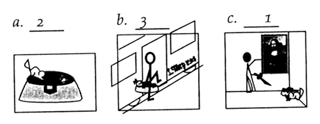QUICK GUIDE
Key Words: Reading
Learner English Level:Here, intermediate level but adaptable to levels
Learner Maturity Level:High school through adult
Preparation Time:Appropriate Sentences--two hours; Unusual view--15 minutes
Activity Time:Varies
This article will offer two activities for getting students to go back into a text whether for review, to clarify, or to glean new insights from a text. Students are sometimes reticent to re-read; I am similarly reluctant to assign students simply to re-read something as it feels like busy work. I like students to have some kind of goal or product when reading, such as to sequence events in the story or to fill in a grid matching characters with traits, for example.
An old standby for reading is to assign comprehension questions. When I do this, I try to design questions not as a means of testing students' comprehension, but as a means of aiding it. Nevertheless, questions seem very much a display type of activity (i.e., one in which the students perform so the teacher can tell them how they well they performed) and may be done less than enthusiastically, if they are done at all. I use the following gambits--as more interesting alternatives to questions--in a high school context but they can be readily adaptable to other situations.
Appropriate Sentences
As a means of confirming students' understanding of vocabulary and situations, and of focusing their effort on meaning above the level of the sentence (to the level of the story), I sometimes use a scrambled sequence of pictures for students to put in order after a reading. These pictures can serve a further purpose of encouraging students to re-read--here as a scanning exercise by asking them to write a sentence from the text which describes the picture. Thus, in the following pictures, which I use with a graded reader called Marcel and the Mona Lisa (Stephen Rabley, 1991, Longman), appropriate sentences might be:

(c) "It's that new guard," he thinks. "And he's . . . he's stealing the Mona Lisa!"
(a) "He runs along the wall very fast, climbs up the tall, black bag, and jumps inside it."
(b) "Five minutes later the Louvre 'guard' gets on a train."
Or,
(c) "What is it? A man? A man with a long knife? Yes!"
(a) "At the bottom of the bag, Marcel can see a face. The Mona Lisa's face."
(b) "Marcel climbs the painting and looks out. 'A rail-way station!"'
Unusual View
The next activity (adapted from Five Minute Activities, Penny Ur and Andrew Wright, CUP, 1992. p. 85) creates such an enthusiastic game-like atmosphere that one may forget its purpose, to get students reading.
The teacher prepares a group of pictures representing words in the text to be reviewed. The pictures are drawn from an unusual perspective. Students guess what the objects are.*

If students cannot guess what the objects are, the teacher gives a hint (preferably, the students ask for a hint.) I usually offer a page number from the text they read. If they still don't get it, I offer a paragraph number. One must be cautious here, however, and bear in mind that when students have their faces buried in their texts, the activity is succeeding. l have found myself giving hints too quickly because I did not want to lose the "momentum" of the game.
After the students have the idea, they can be assigned to create their own pictures for the next reading section.
Answers: 1 sunglasses from the top, 2 a door from the side; 3 a knife from the front; 4. a sign from the top; 5. a railway car from the bottom.
